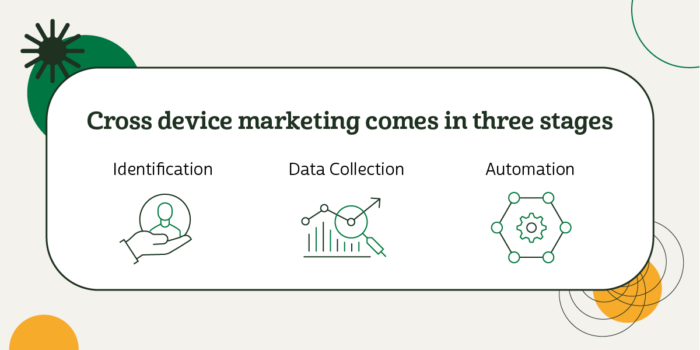
Can you think of the last time you spent all your energy and focus on a single device or platform? It has probably rarely — if ever — happened, right? Sure, you might spend a lot of time in front of the TV, your work computer or even in your home office, but you likely use a variety of devices throughout the day — including your phone, tablets and more.

Today’s consumers do not spend all their time or invest all their resources in a single device or platform. Yes, there are some platforms that are more valuable to them, but that’s not their only focus, and that’s the point. Kids, teenagers and adults all split the time they spend consuming content across a wide variety of devices, platforms and mediums.
Multi-Platform Advertising
Some of those platforms, for instance, you may never even consider. Social media and mobile devices are used frequently, as are desktop and retail sites. But some also consume content via game consoles, smart TV, streaming services, through mobile apps — not just mobile browsers — and more. When advertising across these devices and platforms, it is known as cross platform advertising. For you, it means that in order to make an impact in their lives, you need to have a system for reaching consumers on every device (mobile, tablets, TV, computers).
When you target a specific user or users across multiple platforms, it’s called cross-device targeting or cross-device marketing. Other names for this strategy include people-based marketing, cookie-based marketing and even device ID marketing. It depends on who you talk to and what expert you are listening to. Essentially, all these terms mean the same thing, and the core concept remains intact for each and every name or description of the marketing type.
It’s simple, really. The main goal is to analyze and understand your audience — or specific users — so you can reach them on the platforms or mediums they prefer most, when and where they are ready to convert, ultimately maximizing conversion rates and your return on investment.
For example, let’s say a particular middle-aged man spends a lot of time watching TV, and consuming articles and media content on his mobile device. While he may spend a lot of time on his TV, he never lends any credence to advertising campaigns or marketing efforts he encounters there. Instead, he’s more likely to interact via mobile. In the case of this consumer, launching a similar TV-based campaign to target him would add a second touch point for your marketing message. This would increase the likelihood that he received your marketing message and is ready to take action. Although he may not purchase goods or services via his TV, he is still being impacted there, and his mobile device may assist in the conversion process.
Of course, this is only a small example of how and what cross-device marketing is good for. The idea is to get a much better and more robust understanding of your audience across every device or platform they use and interact with. In turn, this provides a much clearer and more accurate representation of that audience.
Is it any good, though? Is it effective? Well, according to Google, travel companies see a 14 percent uplift in search ad conversions when they use cross-device data. By following their audience — or one type of user — from channel to channel, they are making their marketing efforts more effective, more optimal.
But most marketing strategies have you targeting a swath of users, instead of individuals. What is the point of targeting the same user across channels? Why even bother to market across multiple devices? Why focus on such a small target window?
There are several reasons for cross-device marketing, which we’ll outline now and break down in more detail throughout the rest of this guide. First, targeting a user across devices and platforms allows you to provide a more consistent and seamless messaging experience. In turn, cross-platform advertising allows you to craft an entire campaign that follows the customer along their journey. This amounts to a much better user experience for them and an easier time targeting and customizing your campaigns for you — which leads to better results all around.

Another reason is that you are never truly sure when a user or audience will convert or buy your products along the customer journey. Some may do it sooner than others, some later — and some may never convert. Targeting a specific user allows you to pinpoint when, where, how and why someone might convert. You can then optimize the information you’ve collected to target similar users. In a way, you could say you’re truly perfecting your marketing and cross-platform advertising experience for all.
What Is People-Based Marketing?
In layman’s terms, people-based marketing allows brands and businesses to be proactive and methodically respond and react in real time to customers across devices, channels and platforms. This enables the creation or development of a single, unified customer journey and experience, even across devices. You may have heard of omnichannel businesses before: people-based marketing is how to achieve that goal.
On a grander scale, people-based marketing is about the collection and analysis of real-time behavioral data, trends and patterns. Brands combine multiple sources of data, including first-, second- and third-party data.
People-based marketing got its name because it is focused on the users or people you are targeting. You can create a tailored campaign and journey for them to experience, which activates as soon as they are ready. You see, customers have most of the power in today’s market, as they decide when and where they will be consuming content. They can also decide how much they consume, and what kind of investment they make. Your goal is to reach them in a way that fits their content consumption habits, ultimately maximizing your marketing dollars, and boosting overall revenue.
Mike Juhas, senior director of sales for AdReady, claims a cross-device strategy is an “integral part of any scalable campaign,” meaning that you should already be concerned with using this marketing strategy.
Cross-device marketing comes in three stages — starting with identification, then data collection and use and on to automation. How each stage works is pretty straightforward. First, you identify your users or audience, collect the necessary data and then automate the entire process so you can continue revising, updating and optimizing.

The best — and most renowned — example of people-based marketing is retail giant Amazon’s efforts. Amazon can efficiently identify many target audiences, collect data on them and put all the information into practice through automation. How? They offer a mobile web, desktop, apps, Alexa and even Prime service to their audience. No matter who you are or what device you use, there’s an Amazon experience tailored to you and your platform of choice. That’s all thanks to a people-based marketing system, and the retailer continues to improve the experience across all platforms using the same system. The user experience is virtually identical no matter what device you are using to interact with Amazon.
How Do People Use Devices Differently?
To create an effective and seamless journey for your customers across devices, you first need to understand how and why customers use technology differently. What can a particular device or platform offer that the others can’t? When and where are users engaging with a platform? How do their environment and conditions change how they interact or engage with content?
Desktop Computers
Desktop and laptop computers fit best within a more conventional setting. Unlike mobile devices, users have more power at their fingertips, and that means they can access higher-quality, consistent content. They aren’t usually on the go — though some are — but that doesn’t really matter. Desktop computer users expect the full, unhindered experience. There are many reasons for this — some to do with you and the experiences you offer, others to do with the user themselves.
For instance, one customer might be more inclined to browse content and products from a desktop because it’s more convenient and responsive. The mobile version of a site or app may parse or alter content to fit the smaller display and experience, affecting how that user consumes and interacts with content. Again, this is just a single example, not a general descriptor of all desktop users.
Some may argue that you don’t need a desktop computer to get by anymore, which is certainly true. Mobile devices and tablets can display content even in desktop form.

Mobile Devices and Smartphones
Mobile devices are considered mobile or portable for a reason. Yes, some people still use these devices from the comfort of their home, while sitting on a couch or lying down in bed. However, for the most part, consumers use these devices when they’re out and about. That also allows you — as a brand — to tap into more detailed information, including GPS and location info, habits and patterns, places visited and more. Mobile devices help marketers paint a detailed picture of what their users are like, how the behave and how to best reach them. You can see what stores and locations they went to, how much time they spent at each place and even what they spent their money on. But it doesn’t stop there.
Mobile is all about bite-sized and concise content. You want to get your users involved and engaged as quickly as possible, and you also want to get them free again as quickly as possible. If that means making a sale, converting or engaging, then do so, and do it fast.
Tablets
Tablets are, by far, the hardest to discern from the other devices. Not because the platform is difficult to understand, but because the way that users interact with these devices is constantly changing and evolving. It’s a merger between mobile and desktop experiences. The larger displays on tablets allow them to deliver full desktop versions of a website or app, natively. Some tablets even include or come bundled with physical keyboards, making them act more like a laptop or desktop computer.
That said, sometimes users may browse on a tablet like they do a phone. This may entail delivering bite-sized content, meant to be consumed on the go or quickly. What does this have to do with your cross-device marketing strategies and customer journey?
For tablet users, you need to be able to offer a responsive and reactive experience that can provide a seamless swap between mobile and desktop. In other words, you’re providing your users with the opportunity to decide how they receive content on their tablet, and how they will engage or consume it.
Which Device Is Converting the Most?
Desktop and tablet experiences are important. You shouldn’t overlook the need to develop and provide these experiences to customers.
A November 2016 study reported that mobile Internet usage had finally surpassed desktop traffic for the first time in history. That has not changed, and continues to be the market trend today. To put that into perspective, it means more users are browsing the Internet, apps and content via mobile devices than from conventional desktop computers. That’s a huge and incredibly influential market shift, for obvious reasons.
Mobile is certainly the most important platform right now, and that means delivering a mobile experience should be priority No. 1 for you and your brand. More importantly, your cross-device marketing strategies should definitely take mobile users — and how they’ll be consuming your content — into account.
Just two years prior to the survey mentioned above, a 2014 study reported mobile conversion rates were not as high as desktop. But, as you’ll immediately notice, the sourced report mentions users switching between devices and that tablet conversions tended to be higher than mobile. We can attribute the device-switching habit to the idea that many brands were offering sub-par mobile experiences. If you offer a reliable, consistent experience across devices, then conversions will happen.
How Can I Target People Across Multiple Devices and Platforms?
Not a single piece of this information does you any good if you don’t know how to put it into action. You can understand everything there is to know about cross-platform and people-based marketing, but if you don’t know how to carry it out or deploy these strategies — guess what? — that information is pretty much useless.
Cross-device marketing is achievable if you have a plan of action. Here’s a brief overview of what you need to do to successfully target users across multiple devices.
1. Know Your Audience
The first step in the process is to ensure you know and understand your audience, or your customers. Before you start any new campaign, start planning new strategies, or take action, use the data and information you have to both assess and identify your core audience. Chances are, your audience and demographic may change from campaign to campaign, or channel to channel, that’s okay. The important part is that you understand who you are targeting, otherwise your efforts will be for naught.

You can use data collaboration platforms and data marketplaces like Lotame’s Spherical and Lotame’s Data Exchange to find first, second, and third-party data if you don’t have any of your own to work with. Audience data, especially when dealing with cross-platform marketing campaigns is vital to your success.
2. Prioritize Platform Experiences
Unless you decide otherwise, you’ll want to rank and prioritize the different platforms to decide where to focus most of your attention. Yes, you’ll still want to provide plenty of support across platforms, but you also don’t want to wear yourself too thin. Every industry is different. You’ll need to identify and understand what platform is most important for your business, while delivering a seamless user experience across all platforms and devices. You want to serve your customers the best experience possible because they may be ready to convert and engage on any platform at any time.
Choose a dominant platform and tailor your most important experiences for that channel.
3. Get Creative
This is perhaps one of the most important steps, outside of ranking the various platforms. It’s okay to repurpose campaigns across platforms – it often helps to have continuity in your messaging. However, we suggest tweaking, modifying and customizing campaigns that are specific for different platforms so the user has the best experience possible. For example, when you’re targeting mobile devices, make sure your images are appropriate for smaller device sizes and your marketing collateral is mobile-responsive. Do not — we repeat — do not simply repurpose a campaign to fit another channel or device. Invest the time and resources into creating something unique and colorful for the platform you are currently focused on. This is going to require a healthy amount of customer and audience data, yes, but it’s well worth it.
Your customers are using different devices because they each offer different experiences. You absolutely must adhere to those general experiences. No, that doesn’t mean you can’t get creative and think outside the box, it simply means make sure you are focused on the appropriate channel and audience. Mobile users want bite-sized in-and-out interactions and content, whereas desktop users are okay with more substantial experiences.
4. Write or Develop Your Story
A good book or movie is never devoid of a solid, seamless plot. In fact, you often hear how plot holes or problems within a plotline are the deciding factor between whether or not a piece of content is good, mediocre, or poor.
The same is true for your cross-platform and cross-device advertising campaign. For all intents and purposes, you are telling a story to your audience. You are creating a full customer journey or experience they will follow the entire way through, from channel to channel.
Make certain you have that story properly developed, planned, or laid out before putting anything into motion. With an ad campaign, for instance, make sure you consider all the factors, triggers, and elements of the experience. How will one interaction influence future engagements? What will decide whether a customer is served one piece of content or ad over another? Think of it like a storyboard or wireframe for your entire campaign.
Before you know it, you’ll find yourself building unprecedented marketing campaigns, that are more targeted than ever before. That’s a good thing!
5. Track and Automate
The next step is to get your tracking, analytics, and automation systems in place. This will allow you to monitor things like ad performance, conversions and efficiency, engagements, and more. In today’s market, you need to know a lot more than just whether or not a campaign or investment was successful. You need to understand the how, why, and what worked well, in order to come away with insights you can use to improve future campaigns.
With cross-device and cross-platform marketing it’s all about tracking the trends, engagements, and patterns of your users from channel to channel. The delivery matters, and if or when it works you must be able to duplicate your campaign. Such a thing is only possible if you have collected the appropriate insights, stats, and information.

Optimize for Sequential Messaging and Marketing
One aspect of people-based marketing and effective cross-platform targeting techniques is achieved via sequential messaging. It’s a technique or strategy that calls for pre-configured messages that work in a defined order, similar to a script. They are activated and executed based on the device or touchpoint a user is engaging from.
So, for instance, let’s say a customer is served a generic ad on a retail site for a particular product or service. They then click on this ad to get more information. You don’t want to serve them the same or similar information the next time you see them, because clearly, they’re already interested. Instead of serving the same content to them, you can use sequential messaging to tailor the ad’s content to that particular customer. You can serve them specific content related to the product or service they are interested in.
As an example of sequential messaging, a user would click on a generic vehicle ad for an auto brand. The next step would be to deliver ad content based on the vehicle or model they are interested in. This would take them to a request form for a local test drive, safety and technical specifications, or something similar. Throughout each touchpoint the customer is served something different, yet just as engaging and relevant. It’s a brilliant concept that drives engagement and conversions.
Cross-Device Marketing Makes Your Marketing Message More Effective
Naturally, cross-device marketing improves this strategy and process because it allows brands to tell a cohesive, yet effective story to consumers no matter where they are visiting from. The customer journey and experience is seamless, varied, and effective. Not to mention, sequential messaging campaigns can transcend screens and devices, meaning you can share information and data between platforms.
Someone browsing via desktop who then switches to mobile, can have the same cohesive experience as if they just stayed on desktop. Again, it’s brilliant, effective, and rewarding but it’s also time and resource intensive. In fact, the only way to make it happen is thanks to modern cookie based marketing techniques that share user data and information from platform to platform, or device to device.
In summary, we suggest using the following steps to best target users across multiple devices and platforms:
- Analyze and know your audience
- Prioritize platform experiences
- Get creative with device-specific delivery
- Organize, develop and write your story
- Track and automate your results
You can read more about Lotame’s end-to-end data collaboration platform Spherical, and how we’re helping marketers and publishers everywhere bridge the gap between screens.
To learn more or if you’re interested in a demo, fill out the form below!